Le blanc envahit la ville, XIIe Biennale de São Paulo
What's remarkable is the exceptional energy it took Fred Forest to put together an event of this magnitude on the scale of an entire country single-handedly. Incredible energy, but also a keen sense of communication and operational strategy.
1973 XIIe Biennale de São Paulo
1973 October
Grand prize for communication at the XII Biennial for a series of actions and installations
What's remarkable is the exceptional energy it took Fred Forest to organise such a large-scale event on a national scale. Incredible energy, but also a keen sense of communication and operational strategy.
And all this in a country whose language he doesn't know, and where he had just arrived a fortnight before... To our knowledge, this is a unique phenomenon in the visual arts, perhaps equalled only by the pop concerts of the 1970s, supported by their own commercial vector. A phenomenon which, in our opinion, was not sufficiently emphasised by commentators of the time, when it should have been highlighted by all journalists, not only art journalists, but above all those whose job it is to report the news.
With no permanent team to back him up, but only a handful of occasional people who were attracted by his approach and met him on the spot to help him, Forest has achieved this unusual feat. It took 50 years (half a century...) for this primary truth to finally be recognised. Of course, his official invitation as part of the international section on communication set up that year at the XIIth Sao Paulo Biennial brought him contacts and opened doors. In particular, Professor Vilém Flusser, himself an advisor to the Biennale, whose favourite artist he would become in the years that followed, brought his closest friends with him as soon as he arrived in Sao Paulo.
Gabriel Borba Filho, José Bueno, Milton Vargas, Haroldo de Campos and Radah Abramo. The latter, a well-known art critic, was none other than the wife of Claudio Abramo, then director of the major newspaper La Folha de Sao Paulo. Having learned of Forest's project to criticise the current military regime, she improvised a press conference for him.
This initiative, in line with the ideology of the intellectuals who abhorred the undemocratic regime, put Forest in the media spotlight, promoting him overnight as the most important of the 200 participating artists. This privileged position would above all give him the opportunity to multiply his interventions with the written press, radio and television, which were the ideal supports for his creations. What's more, the Biennial's official administration was surprisingly generous in its support for his projects. Fifteen major newspapers covering Brazil have signed up to his participatory Space Media operation, inviting readers to express their views.
Lastly, Fred Forest set up fifteen telephone lines on his stand, each equipped with an answering machine and a loudspeaker to broadcast the contributions of correspondents who were asked to express themselves freely, without censorship, for the allotted time: two minutes. Calls poured in from all over Brazil, with national newspapers such as O Estado, Globo, Jornal do Brasil, La Folha etc. regularly broadcasting the call for participation.
Buoyed by the momentum of his interventions, Forest improvised beyond the initial project that he had communicated to those in charge. The latter were extremely lax towards him and let him do as he pleased, never intervening, even when the political police came to his stand to order him to remove certain messages from the walls. With his personal animation permanent on site, Forest, boosted by the success, announced that his animations were now going to leave the "framed" art of the Biennial and return to the street. The Brazilian press was incredibly faithful in relaying every piece of information he gave to the public, providing the artist with an exemplary and precious tool that he was able to maintain through the friendships forged day by day in the course of his actions.
His events now take place in the space of an entire city. It distributes papers where people can express themselves, and the harvest of precious responses will reach the Biennial's picture rails where they will be displayed. Always announced by the press and attracting large crowds. The most recent of these was "White invades the city", where white placard-bearers took to the streets, inviting people to talk amongst themselves, while the police punished any group of more than three people on the pavement. This activity resulted in his own arrest and imprisonment for 4 hours. Undaunted to say the least, the artist answered all the police's questions with a devastating sense of humour, before answering questions from TV Globo as soon as he was released, and from journalists from the print media who rushed to broadcast everything the very next day, thus maintaining a momentum that his personal know-how amplified...
Concept
This action should be seen in the context of 1973, when Brazil was ruled with an iron fist by a military junta. The artist's provocation consisted in trying, using the mass media, to create "spaces" for freedom in the press and free expression in the streets. Naturally, he soon found himself confronted with the brutal threats of a police regime whose bans he managed to circumvent, thanks to the active complicity of Brazilian journalists on the ground. His status as both a guest artist and a foreigner gave him some leeway. Aided by the circumstances, he succeeded in creating a critical event on an international scale, relayed by newspapers all over the world, calling into question the military political regime of the time. Once again, Forest's innate sense of the event, his perfect knowledge of the workings and malfunctions of the information system, and his unflagging morale, energy, radicalism and practical imagination are all to be noted. For him, socio-political 'happening' and protest only make sense if they are relayed by the mainstream media. While in some ways the artistic practice of sociological art is akin to the Dada or Situationist approach, in the field it takes on an entirely different dimension, through its direct confrontation with the powers that be, and through its social impact via the mass media. In fact, its critical force and capacity are out of all proportion to the watered-down statements of certain artists whose "activism", which is exalted to the pinnacle by contemporary art circles, is in fact nothing more than a sham and therapy for internal use, designed to ease their conscience.
Device
A dozen telephone lines were installed in the Biennial space. The telephones were placed on white pedestals, facing the public. The public can hear the calls amplified on the spot. These continuous calls emanate from all over Brazil. There are many of them. The invitation to take part via the telephone network was repeated every day in the major daily newspapers, on the radio and on "O Globo" television. Callers have a full two minutes to get their message across over loudspeakers, before being cut off by a technical device.
- A series of press releases encouraging the public to write messages that were posted on the Biennial's walls as soon as they were received by post.
- A series of TV and radio broadcasts, produced with art critic Aracy Amaral, featuring several live interactive actions.
One of them will involve more than 300 taxis in a chase through the streets of the city... - A fixed installation carrying out an "electro-sociological autopsy and analysis of Augusta Street" in real time, with 60 television monitors installed in the Galerie Portal, while a camera continuously covers the entire length of the street, an action known as the "small museum of consumption".
- A series of urban actions carried out in different public places: supermarkets, stadiums, public squares, samba schools, etc. The last of these actions, "White invades the city", consisted of fifteen people moving around the centre of São Paulo, brandishing white signs at arm's length. The action brought together several thousand onlookers, blocking traffic for two hours and eventually leading to Forest's arrest. Interrogated for ten hours at the headquarters of the D.O.P.S. (Department of Political Police), the artist was released after joint intervention by the Biennale organisations and the French Embassy.
To be meaningful, all Fred Forest's actions need to be placed in the political context of the time.
The country is ruled by the military, who have been imposing a repressive regime for several years. Throughout his stay, the artist benefited from the active complicity of opposition journalists. The "pretext" of art gave him the critical freedom that made him the Biennial's "protest" artist, and its emblematic figure. Two years later, Forest renewed his provocation. Uninvited, he went to the 13th Biennial, where he created a Biennial in competition with the official Biennial. It was a parodic event that met with enormous media success. This Biennial, known as the "Biennial of the Year 2000", was intended to "ape" the first Biennial and to analyse it critically.
- Catalogue XIIe Biennale de São Paulo… Fondation Biennale 1973, São Paulo.
- " Fred Forest arrêté au Brésil ", La dépêche du Midi, 9 novembre 1973, Toulouse.
- " Fred Forest relâché par la police brésilienne ", Le Progrès de Lyon, 9 novembre 1973, Lyon.
- " Des artistes en vedette ", Tribune de Genève, par Arnold Kohler, 9 novembre 1973, Genève.
- " Le Brésil n'apprécie pas l'art spontané ", La Gazette de Lausanne, 9 novembre 1973, Lausanne.
- " Art in Brazil ", Hérald Tribune, 27 décembre 1973, Paris.
- " O branco invade a cidade ", Folha de São Paulo, 6 novembre 1973, São Paulo.
- " Branco invade São Paulo ", Jornal do Brazil, 8 novembre 1973, Rio de Janeiro.
- " Fred Forest faz passeata em favor da arte livre ", O estado, 8 novembre 1973, São Paulo.
- " O communicador da bienal foi se explicar na police ", Jornal da tarde, 7 novembre 1973, São Paulo.
- " Entre na bienal pelo telefone ", Veja n° 267, 17 octobre 1973, São Paulo.
- " Bisturi na T.V. autopsia da rua Augusta ", Veja n° 276 décembre 1973, São Paulo.
- (Nombreux autres articles à voir dans bibliographie générale sur le site du Webnetmusem)
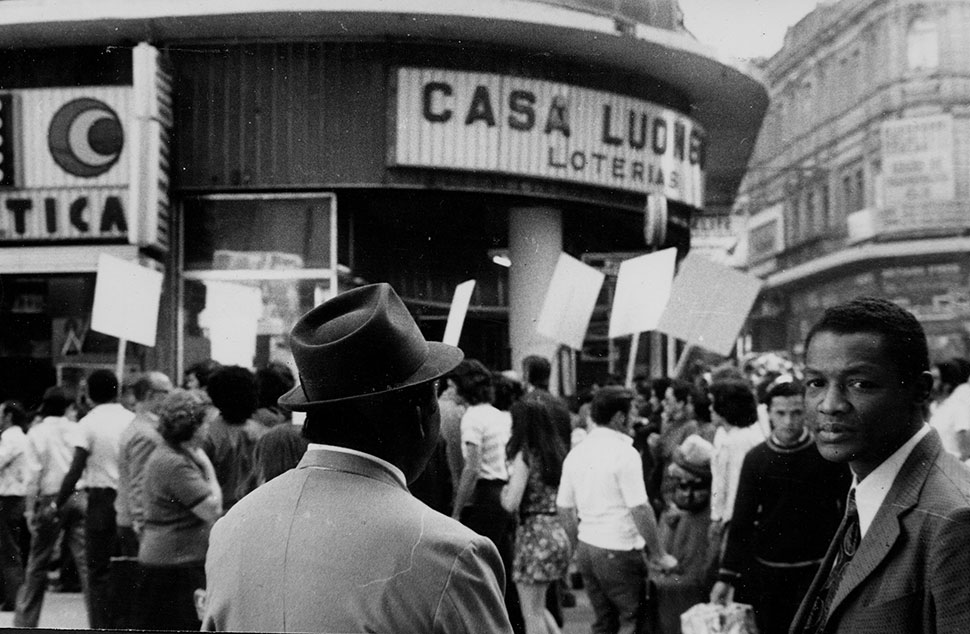
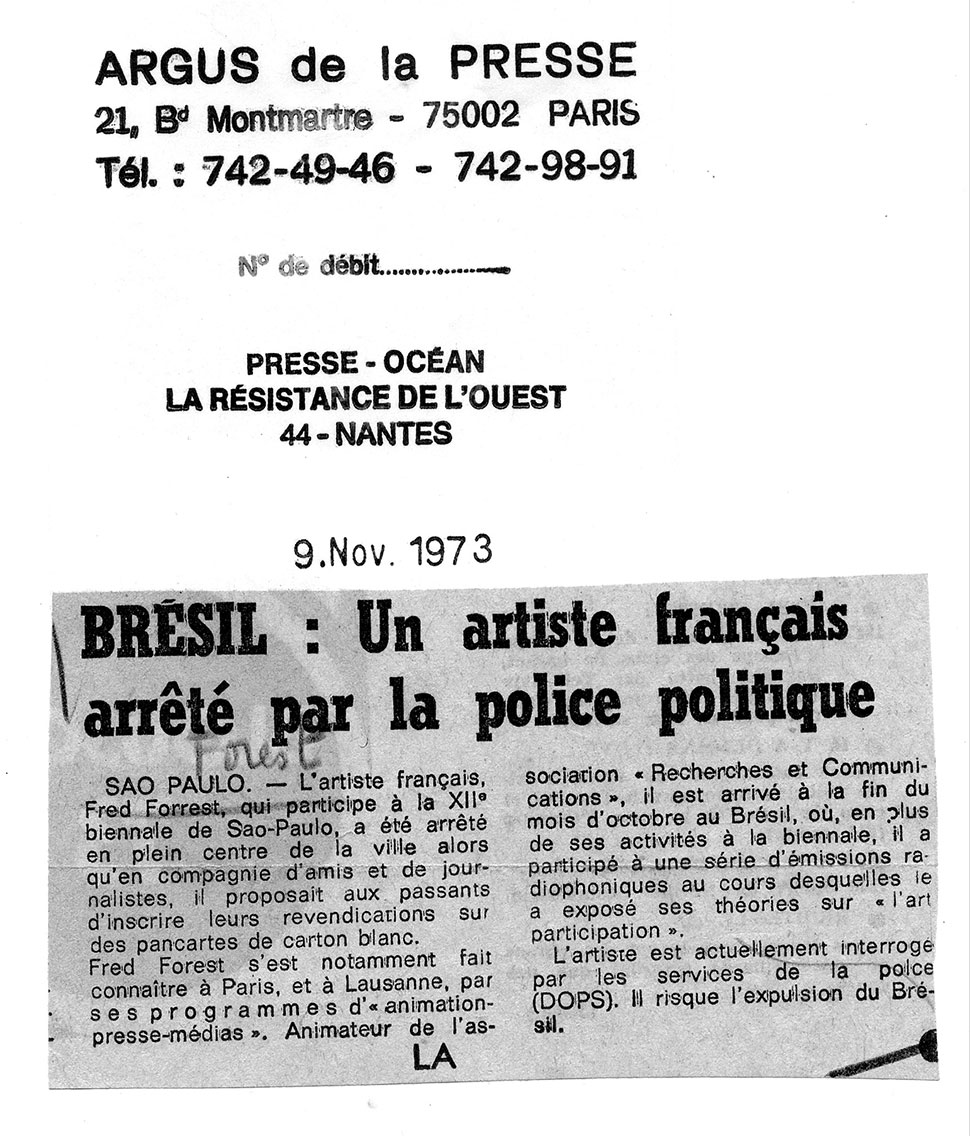
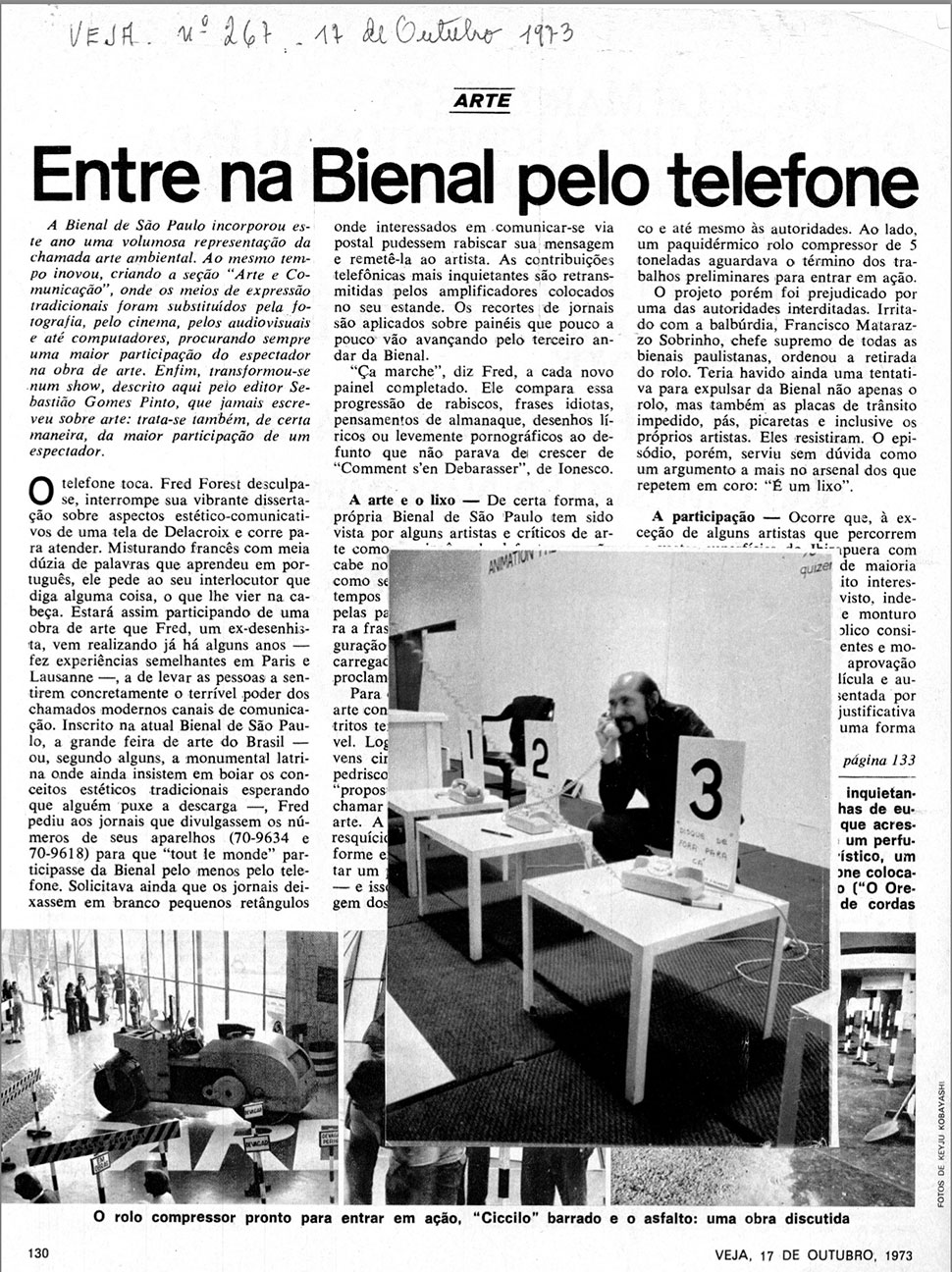
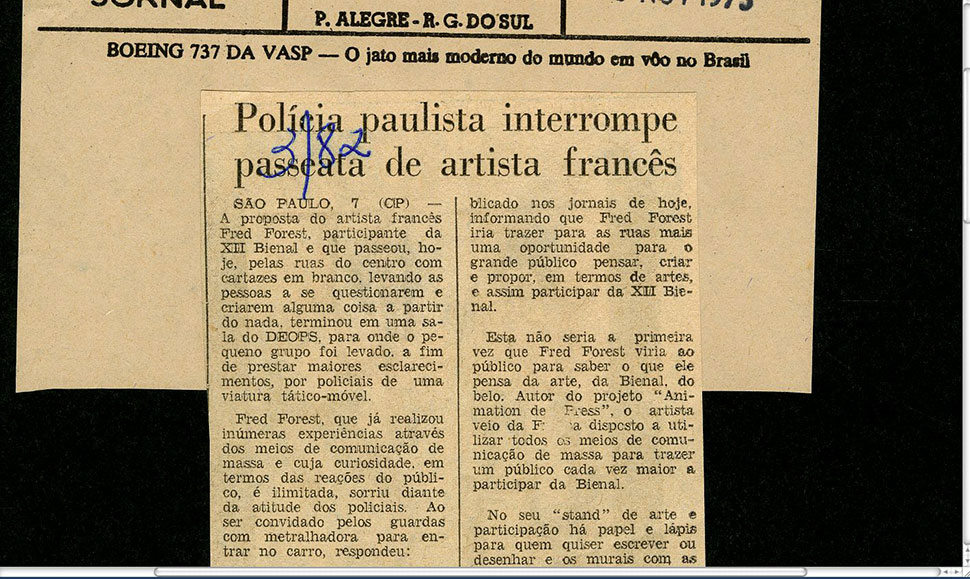
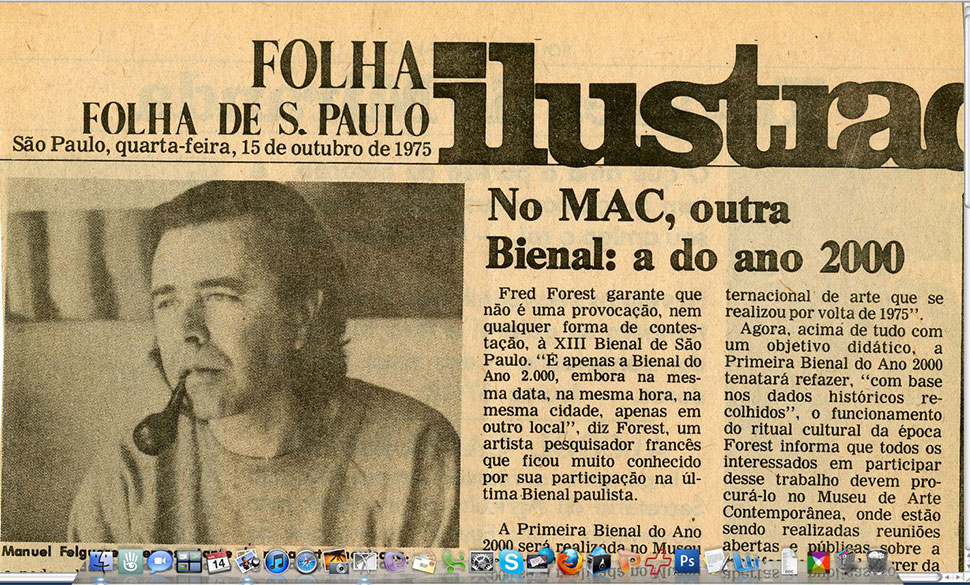
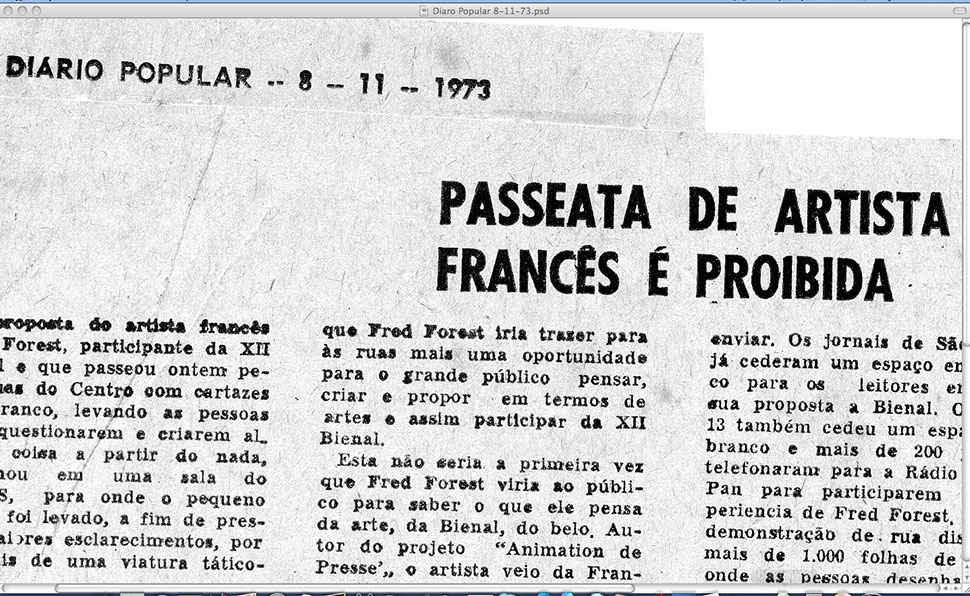
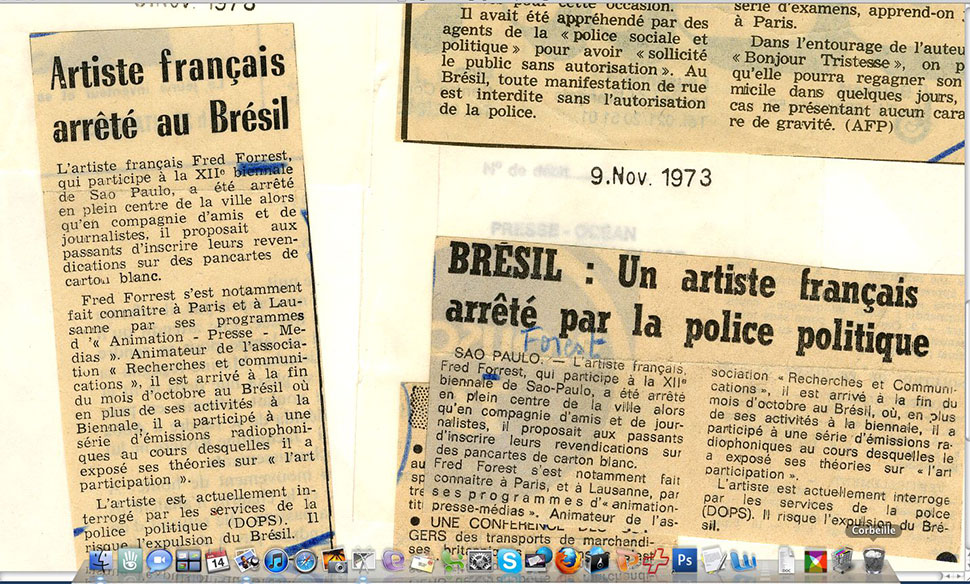
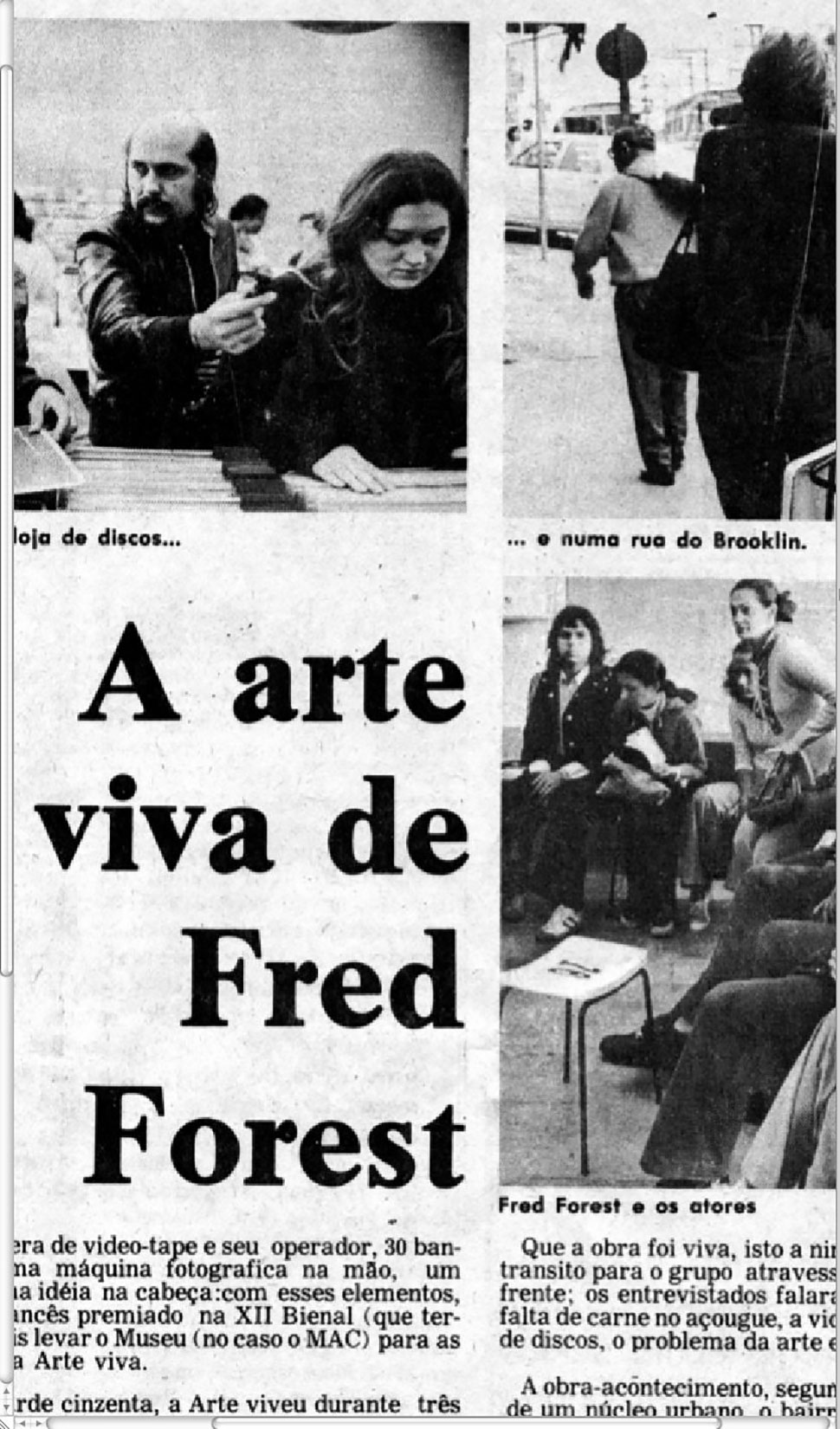
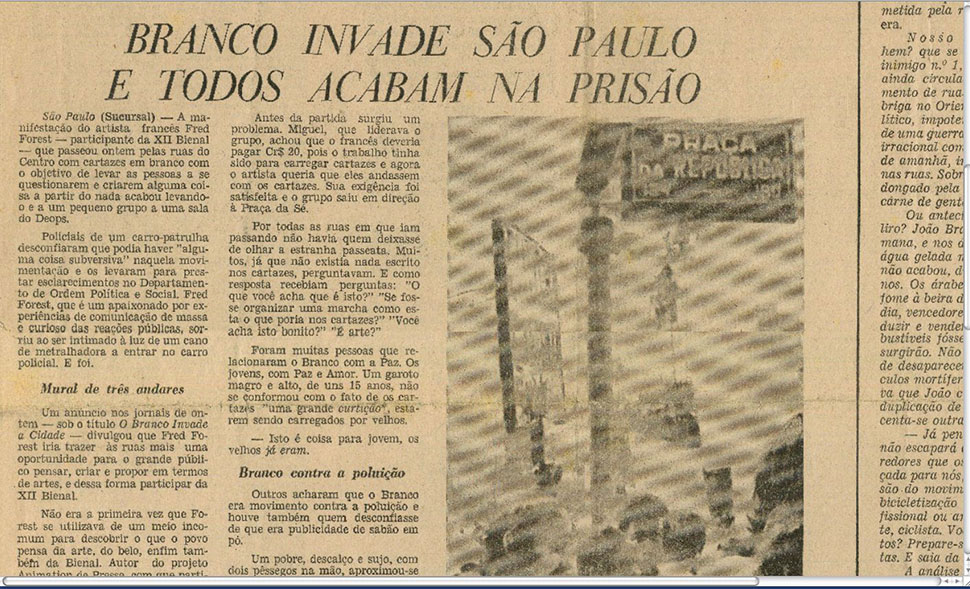
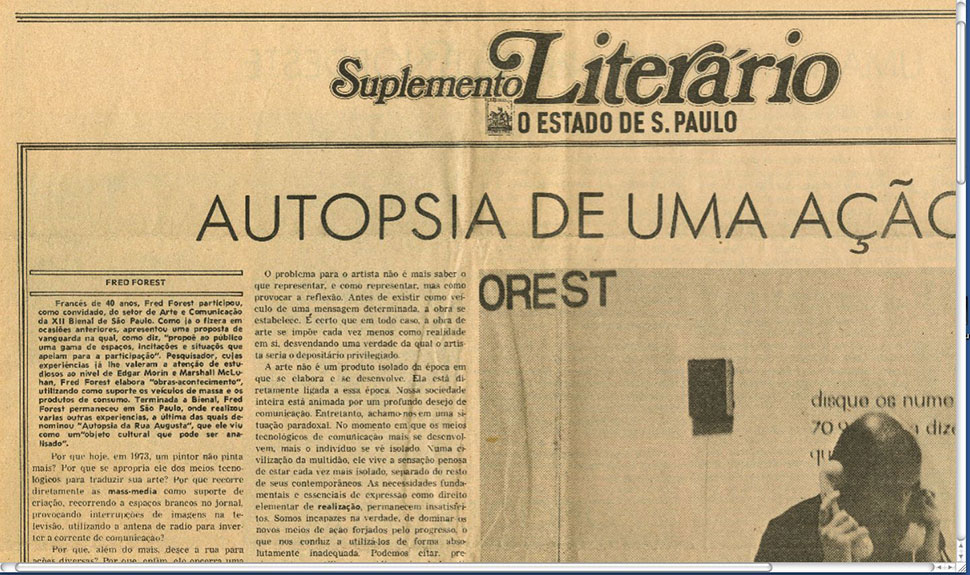

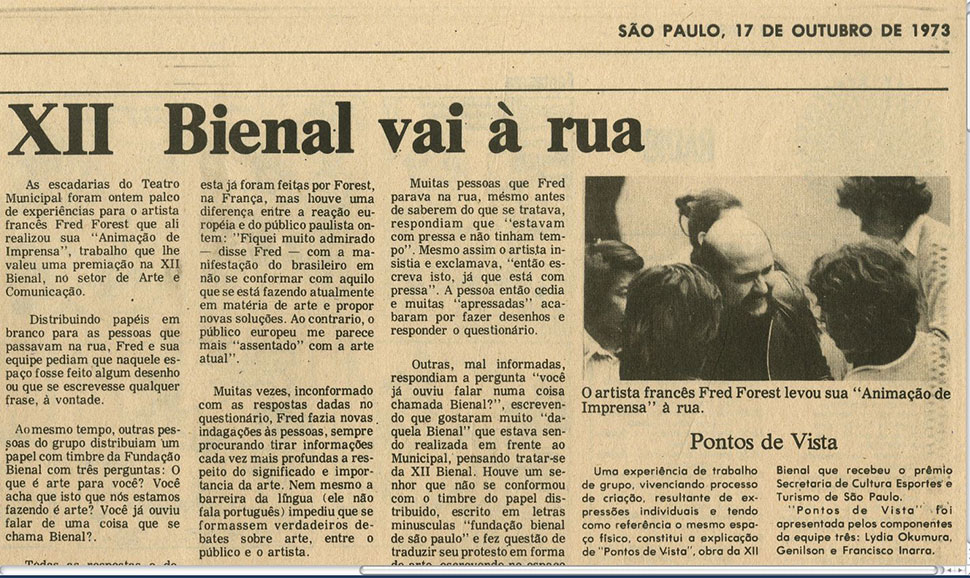
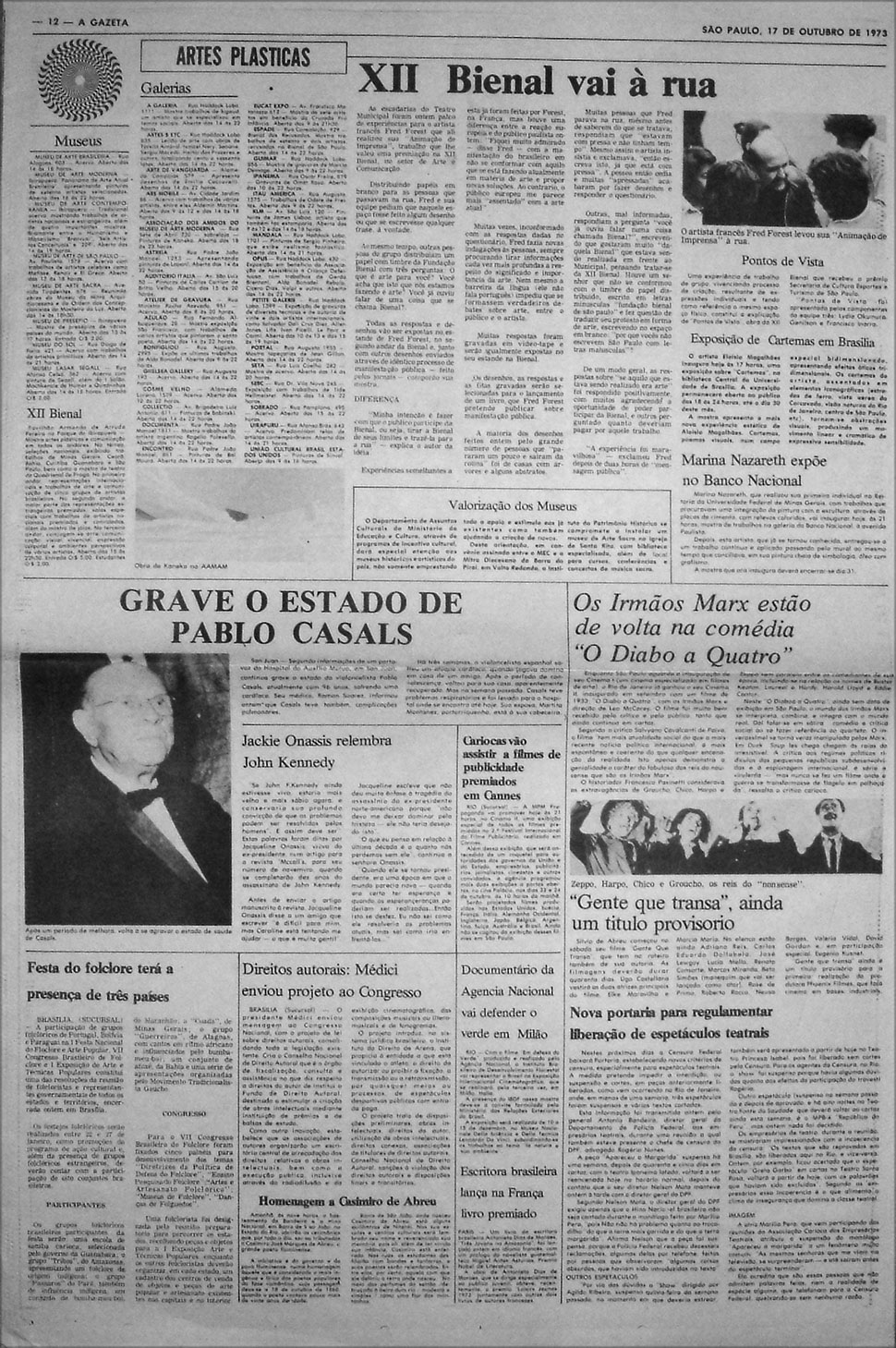

LONG BIOGRAPHY OF FRED FOREST
Fred Forest has a special place in contemporary art. Both by his personality and by his pioneering practices which mark his work. He is mainly known today for having used one by one most of the communication media that have appeared over the last fifty years. He is co-founder of three artistic movements: those of sociological art, the aesthetics of communication and ethics in art.
He represented France at the 12th São Paulo Biennale (Communication Prize) in 1973, at the 37th Venice Biennale in 1976 and at Documenta 6 in Kassel in 1977.
EXHIBITION AT THE CENTRE POMPIDOU FROM JANUARY 24 TO OCTOBER 14, 2024














